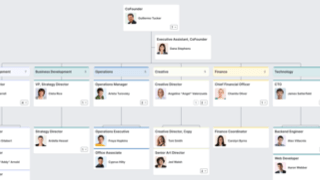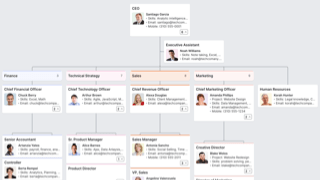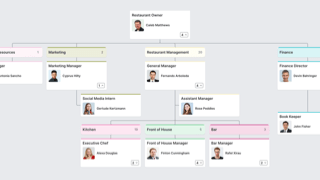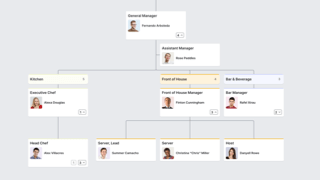What Is an Organizational Chart and Why Is It Important?
Organizational Chart Definition
Organizational charts (or hierarchy charts) are the graphical representation of an organization’s structure. Its purpose is to illustrate the reporting relationships and chains of command within the organization. Employee names and titles and/or job positions are generally depicted in boxes or circles with lines linking them to other employees and departments. By looking at the company organizational chart, people can gain a quick understanding of how the organization is designed, its number of levels, and where each employee fits into the organization.
Purpose of Organizational Charts
In the past, organizational charts have been used primarily by Human Resources, business leaders and new hires. HR is often responsible for maintaining the org chart by updating it with new hires and when employees change positions or leave the company. When other business units need the org chart, they know who to go to. Business leaders use the organizational chart in several instances, such as for presentations, to justify adding or reducing headcount, and to determine where an employee might have the opportunity to shift job roles.
For the new hire, the organization chart can be a lifeline, helping them to learn names and titles and to better understand where they fit into the overall corporate structure. New hires get names thrown at them constantly and the org chart can be a great resource to find out who all those people actually are. Any employee, in fact, can benefit from having their co-workers names, photos, and professional and personal profiles at their fingertips.
Organizational Chart Templates for Microsoft Office Tools
If you're trying to create an org chart in Word, Excel, or PowerPoint, here are a few templates to get you started.
Benefits of Modern Organizational Chart Software
Because modern org chart software is often a cloud-based application, every edit is automatically saved in real time, ensuring only the latest version is published. When it comes to making those updates, HR doesn’t have to be the only one with the responsibility. In fact, solutions today can even sync data with other internal HR systems to ensure the org chart is always up to date. Employees and managers can get into the app just as easily to make changes as well.
Employees can upload headshot photos or get creative with facts about themselves. Companies can make this fun, asking employees to upload a photo of them with their favorite team jersey, beloved pet, or enjoying their favorite hobby. These pictures can be a great way for employees to present a different side of themselves, helping them to humanize their job title and encourage dialogue amongst co-workers.
Beyond job titles, the software includes opportunities for organizations to add custom fields, such as past education, current projects, “Ask me about…”, related training, and specific skill sets, just to name a few. These are bullet points that are highly beneficial for anyone searching for someone with a particular knowledge base. These efficiencies add up quickly. By presenting every employee and their experience at the fingertips of users, people find who they need quickly so they can be more productive and get to know one another much faster.
Business organization chart software connects people, no matter who they are, what they do or where they work. This is the ideal solution for a growing company, a dispersed workforce, or any organization looking to foster a collaborative culture of sharing ideas and information
Imagine walking to a meeting and being able to scan the bios of everyone who will be in that meeting while you are on your way. No more awkward introductions or forgotten projects on which you may have worked together. With the tap of a finger, you can see exactly which projects on which you’ve collaborated, who they report to and personal facts that help start a conversation.
Each employee profile links to their contact information, making connections simple. Some software includes a vacation and work schedule, making it easy to see when the best time to reach someone might be and who their backup is when they are out.
The organizational chart suddenly becomes a vital resource for the entire organization, becoming part of the daily routine and something everyone enjoys using.
Organizational Chart Examples
Here are a few examples of org charts built in Pingboard.
Org Chart Use Cases
Not every organization uses organization charts the same way, however, those who have implemented modern org chart software find they can do more than they anticipated when they first purchased it. Here are a few use cases to give you an idea of how today’s org charts can be beneficial to an organization.
New Hire Onboarding
When a company hires a new employee, the onboarding process is often slow. The new hire may even say it is painful. Why? Because learning your way around the new office is hard enough, knowing who you need to know is another beast. Studies show one of the biggest challenges for new hires is learning about their coworkers and who does what. Being introduced to dozens of people daily can be overwhelming, confusing and even frustrating. Most new hires want to impress right out of the gate, but if they don’t know who to go to for help and information, they spend the bulk of their day searching instead of producing results.
The business organization chart shows new employees the instant they come on board, and how they fit into the company. Using the org chart app, they can quickly learn who is who, who does what, who works where, and who they need to get to know. For instance, if the new employee is hired in marketing, they need to know the person in legal who needs to review their work. By simply searching in the org chart app under “legal,” the names of every person in legal will be presented. From there, the new employee can drill into each profile to find out who works specifically with marketing.
The new employee can read a little about the attorney and then tap his picture to be instantly connected to him via phone or email. Even better, the new hire can see where the attorney is located to walk over and personally introduce himself.
Another way the software can benefit new hires is by helping them put faces with names. Because org charts can serve as an employee photo directory include photos, the new hires can type in a name and instantly see their picture. This can be helpful before and after meetings, and to learn team members’ names quickly.
Engaging Remote Employees
Today’s workforce is markedly different from even a decade ago. Gallup reports telecommuting for work has climbed to 37 percent in 2015, up nearly 10 percentage points since 2008. More companies are allowing employees to work remotely or have a dispersed workforce structure. These employees may only rarely step foot in the corporate office, making it difficult to feel part of the team.
While companies who offer flexible work environments and hours are more likely to draw high-demand workers, it can be challenging to help them connect with co-workers. Org chart software is one way organizations can bring a virtual team together. Because every employee has detailed co-worker information accessible from their mobile device, they can quickly find who they need and connect with them. They can see their photos, read their profiles, and find details to connect on a more personal level. Being remote no longer has to mean being alone.
Increase Employee Productivity
Employees spend hours every day looking for people and information. When combined with every employee per day, the number of wasted hours increases exponentially. One study puts the number at 2.5 hours per employee per week searching for people and information. This has a significant impact on productivity and efficiency.
Org chart software helps people find who they need, even if they aren’t sure who they are looking for. Take, for instance, a person in finance who needs to speak with someone in HR but they aren’t sure who. By inputting a few keywords in the search box, similar to a Google search, they can rapidly find every person in HR who fits that description. They can then drill deeper into each HR profile to further narrow their search. Instead of sending emails or interrupting others to ask for this information, they have it all at their fingertips whenever they need it.
Improve Employee Happiness and Productivity
Studies have shown that what makes people happiest isn’t their income, but relationships and health. The workplace is ripe for these relationships yet many still feel isolated at work. Up to 70 percent of people say having friends at work is the most crucial element to a happy working life.
CEOs can make a significant impact in the lives of his or her employees by giving them a platform to build those relationships. Modern organization charts help people connect in ways no other software does. It gives them information they can use to be more productive, but also details about each other that help forge friendships.
Most organizations who use this software enjoy adding more personal fields to make the profiles more interesting. Including searchable items such as pets, favorite foods and restaurants, most recent vacation spot, hobbies and /or interests, engages employees on both ends. People typically like talking about themselves and telling their story while others enjoy finding new facts about their co-workers. This also helps bridge gaps where employees may have never had a reason to speak. Now, when they can find common interests and backgrounds from these profiles, employees can start a conversation that often leads to real relationships.
Find Career Growth Opportunities for Employees
Another factor in keeping employees happy involves growth opportunities. Gallup found that opportunities to grow are among the top three factors that keep employees content. Org chart software helps everyone discover the skillsets that may not be available in their own department. The pool of talent suddenly expands, giving employees the flexibility to use their talents and abilities across departments and across the company.
It all starts, however, with communication. Every employee in the company should know what they are expected to do, how their role contributes to the overall success of the company, and where they have opportunities to grow their skills. Companies must define roles and individual growth paths to give employees something to aspire to and then provide the education and training to get there.
When companies can engage their employees, connect them to each other in both professional and personal ways, and help them be more productive, it’s amazing what can happen. If you haven’t seen what modern org charts can do, it’s worth the research to discover its many benefits.
Challenges with Traditional Org Charts
There are several problems with the traditional org chart, however. The most obvious is that up until recently, it was a static document. HR doesn’t always remember or have time to make the updates, particularly when a company is growing rapidly and adding headcount on a regular basis. The org chart quickly becomes a historical document rather than a real-time resource. Every added or changed position requires a manual edit, then the new document must be redistributed. By the time everyone has the updated chart, it’s outdated the second any position is added or changed.
The counter-effect of all of these required edits is it changes perceptions of the chart’s usefulness. Everyone understands it is likely inaccurate so they either make do with bad data or they choose not to use it at all. Instead of it being a real-time representation of the company, it is theoretical. Not exactly the kind of data business leaders can depend on for making sound decisions.
Another issue with outdated tools are they have a difficult time adjusting to the more creative and progressive organizational structures of many of today’s companies. Instead of the easily illustrated structures of product- and division-based companies, for instance, we are seeing more “flat” and “holacracy” structures that actually have very little structure to them at all. These organizations have a cross-collaboration culture that encourages everyone to do what needs to be done, work in multiple teams and offer their talents wherever they can best be leveraged. Instead of silos, these companies are more a “team of teams.” While this design may foster innovation, creativity and collaboration, how do you draw the lines to represent it?
Thankfully, with emerging technology, organization charts has come into this digital age. Modern org charts can do much more than diagram with boxes and lines. In fact, org chart software solves all of the problems inherent with Visio and PowerPoint, for instance, while adding features every employee can appreciate. It’s no longer just a management tool.



